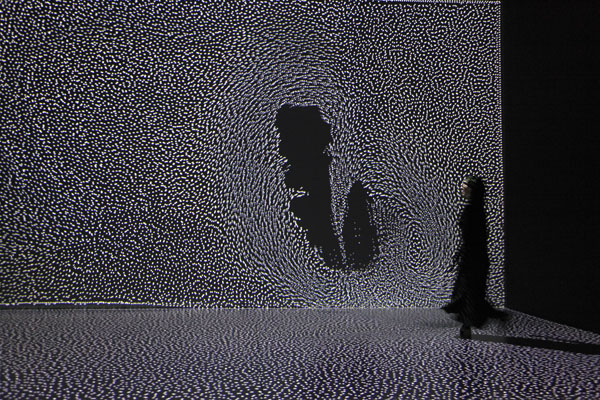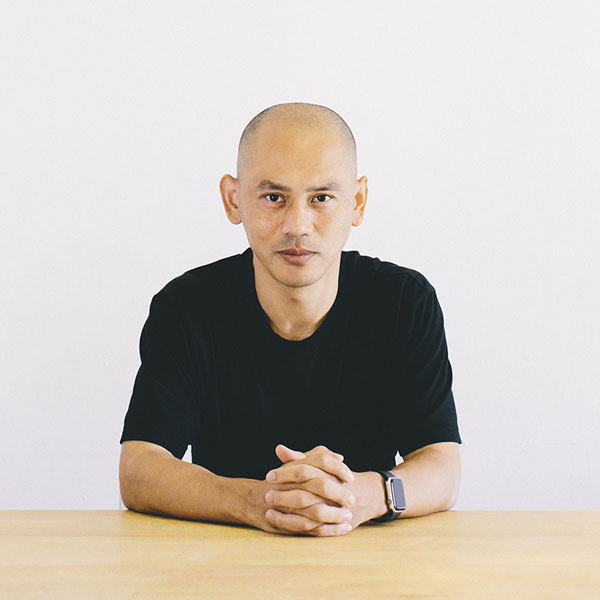
MMM – Installations by Hiroaki Umeda
8-12.9.2022
The Box, Freespace
Mind, Movement, Media, Micro, Macro... these various English words starting with the letter M can sum up the works of Japanese artist Hiroaki Umeda and describe his personal worlds. The artist believes that although each of his works has different creative concepts, the audience can obtain physical sensory experiences on human bodies from all of them.

Haptic Installation (2010)
This installation, with both monochrome and colour versions, is inspired by the dance version of Haptic (2008) with which Hiroaki Umeda extends his exploration on how our bodies make sense of colours. People usually give different meanings and project different emotions to colours based on their cultural backgrounds and learnings. While for the artist himself, colours are merely a source of bodily stimulation.
Grid lines either in monochrome or in colour, synchronizing with the violent electronic sounds heard from the headsets, are still physically “seen” by the audience even with their eyes shut in the form of photic stimuli. The work is considered a dance piece by the artist, through the physical experience of chromatic vision pushes visitors’ senses to their extreme to project a conflict between “cognition” and “experience”.

kinesis #3 – dissolving field (2019)
The primary creative concept of this work stems from how to represent gravity in space. The interactive installation captures various body movements of the audience and turns them into abstract particles, “Once you walk into the installation, you are the gravity”. These particles converge and flow in response to the changes in gravity caused by the audience's entrance and exit, and the movements of their different body parts. “A person's movements trigger different particle streams, which affects the dynamic field of the entire space.” The work aims to prompt the viewer to experience “how the presence of one individual affects the space as a whole, even it might be against your will”.
indivisible substance VR (2022)
In addition to online program and live performance, indivisible substance can also be enjoyed as a virtual reality (VR) installation. Long before the pandemic, Hiroaki Umeda had been experimenting with ways of developing different formats of presentation based on the same work. As audience’s viewing habits change as a result of the pandemic, an opportunity arose for Hiroaki to put his ideas into practice. The artist tries to devise a system that allows dance works to flexibly traverse virtual space and physical theatre. The works that are presented in various formats, just as providing different entrances through which audiences can “enter from different vantage points in order to appreciate the works”.Creative Team
Haptic Installation (2010)
- Direction
- Hiroaki Umeda
- Sound & Image Design
- S20
kinesis #3 – dissolving field (2019)
- Direction
- Hiroaki Umeda
- Visual Programming
- Gabor Papp
- Sensing Programming
- Ryota Sakurai
indivisible substance VR (2022)
- Direction, Choreography
- Hiroaki Umeda
- Music
- AOKI takamasa
- Visual Direction
- S20
- Visual Creation
- THINK AND SENSE
 Photo by: Aya Tarumi
Photo by: Aya Tarumi
About Hiroaki Umeda
Choreographer and multidisciplinary artist Hiroaki Umeda is recognised as one of the leading figures of the Japanese avant-garde art scene.
Since the launch of his company S20, Umeda has toured internationally to audience and critic acclaim and is acknowledged for his strong digital background, holistic artistic methodology, and for incorporating physical, optical, sensorial and spatiotemporal components. His interest in choreographing time and space has also led to work as a composer, lighting designer, scenographer and visual artist.
Solo works such as Adapting for Distortion (2008), Haptic (2008), Holistic Strata (2011) and split flow (2013) combine digital imagery, minimal soundscape and potent corporeality, and have transfixed audiences at major festivals and theatres worldwide. In the choreographic project Superkinesis” (2009–2019) Umeda worked with dancers of distinct physical backgrounds to explore kinetic languages and the environment. Since 2010, Umeda has created installations exploring optical illusion and physical immersion. A series of works combining visual and physical sensation earned him the Prix Ars Electronica, Honorary Mention, in 2010. In 2014, Umeda launched the “Somatic Field Project” to nurture young dancers and develop his movement method “Kinetic Force Method”.
Umeda is appointed the first choreographer of their new choreographer system at Yokohama Red Brick Warehouse No.1 from 2022.